Ruler Analytics attended Digital City Expo for two days of exhibiting, inspiring talks and networking. We wanted to share our top takeaways from the event so that you can apply them to your business and help boost performance.
Digital City Festival came to Manchester for the first time between the 9th-13th March 2020.
At Ruler Analytics, we got the chance to exhibit at the Digital City Expo, which took place on March 11th-12th at the Manchester Central Convention Complex. During the two days, we also got the chance to attend the incredible lineup of speakers who joined this year’s event.
Digital City Expo is a two-day event that brings together the leaders, creators and groundbreakers shaking up the digital and technology sector. It’s a chance to network, learn and explore the latest innovations in marketing and tech.
As there was so much to see at Digital City Expo, we thought we would put together our key takeaways which you can apply to your sales and marketing to boost performance.
Note: Obviously, I wasn’t able to make it to all of the speakers at Digital City Expo. So, if I have missed an important insight, please reach out to me using my social icons below so that I can include them in this takeaway.
Working smarter is the key to getting more out of less.
This is something that I have tried to get better at lately.
When I heard Sal Mohammed, Partnership Manager of Adzooma, was doing a session on “working smarter, not harder” I made sure to put him at the top of my list of speakers to see.
Sal took centre stage in the keynote after Microsoft sadly pulled their employees from the event. Despite the pressure, Sal delivered a great session on how to work more efficiently.
Note: Before I get stuck in, you can reach out to Adzooma and request the full keynote slides if you’re interested to see more.
In the first portion of his presentation, Sal spoke about how the internet has changed the way we work.
“The internet fundamentally has changed the way we work, rest and play. No longer is productivity a simple equation of output divided by hours worked. It’s brought about an increased need for critical thinking, problem-solving, creativity and perhaps no more so than in the world of marketing.”
He then moved onto a visual presentation, looking at the different types of marketers in today’s climate on a hard vs. smart graph.
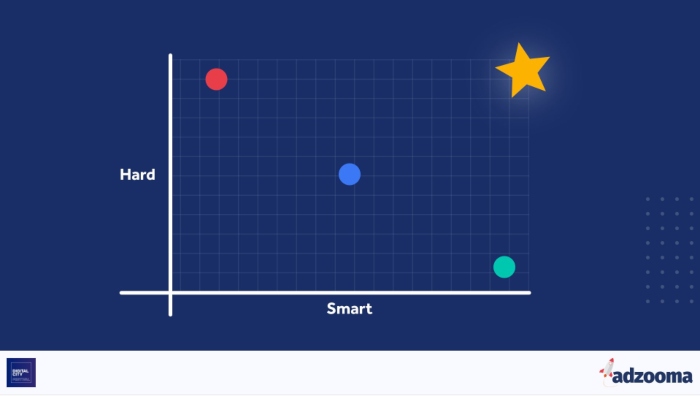
Source: Working Smarter, Not Harder by Sal Mohammed, Partnership Manager at Adzooma.
Sal revealed the reason why so many of us find it so difficult to be efficient is that: “part of it is societal, and part of it is genetic.”
Luckily, there are some principles that can transform your efficiency, which I will cover in the next three points!
“As machines become more and more efficient and perfect, so it will become clear that imperfection is the greatness of man.”
There’s this on-going debate: How automation will replace our jobs in marketing.
Should you be worried?
No. Quite the opposite
After Sal finished his presentation, keynote host Richard ‘clean hands’ Gregory (you should get it if you follow him on Twitter), treated us to a Q&A on the future of automation.
It was interesting in many ways.
Mainly because the experts chosen for the panel had a lot of exciting things to say on how we can get more out of automation (which I’ll get to next).
Although, due to a change in the keynote schedule, our Head of Marketing, Dave Smithbury, was asked to participate in the Q&A discussion.
Of course, he accepted.
And, here is Dave in all his glory:
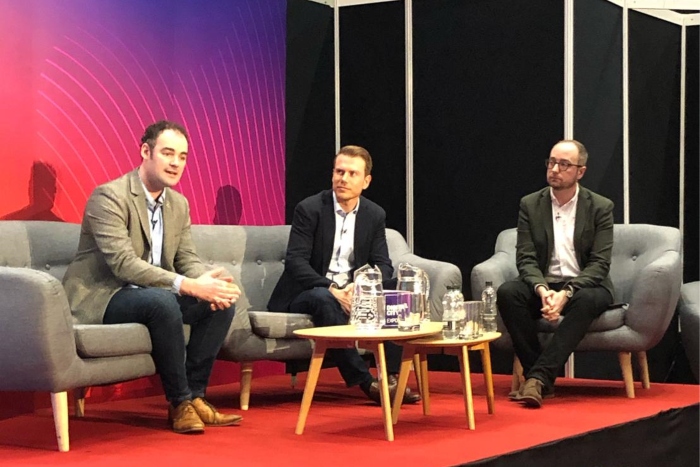
Left To Right: Liam Patterson, CEO at Bidnamic. Robert Wass, Founder and Managing Director at Adzooma. Dave Smithbury, Head of Marketing at Ruler Analytics.
Despite having 10-minutes to prepare, Dave did an amazing job.
Anyway, back to the topic at hand.
Alongside Dave in the panel was Robert Wass, Founder and Managing Director at Adzooma, and Liam Patterson, CEO at Bidnamic.
During the Q&A Richard asked the panel, “can automation save us from the skills shortage in the long-term or are people too scared of automation?”
Robert Wass, Founder at Adzooma, replied with, “It’s a bit of both. Ultimately, automation isn’t going to solve the skill shortage, but it can help. If you can automate tasks and save time and money, then you can get more of your skilled workers saving their time. They’ve got more time to spend on things that matter and are going to make a difference”.
He continued to say, “Also, that time and cost-saving you can reinvest. You can upskill people in your business which is important.”
Liam Patterson used his personal experiences to approach the question, “we don’t get any push back from clients [on automation]. Because, when we explain and when they understand the amount of things they’d have to compute, it’s going beyond what human knowledge can manage.”
Automation can also rid us of one of the biggest source productivity loss and creation of errors: multitasking!
During his presentation on ‘working smarter not harder’, Sal Mohammed said, “only 2% of us are proficient at multitasking. Jumping between different tasks constantly can cause us to lose up to 40% of our productivity.”
So, to summarise. You shouldn’t fear automation, instead, embrace it. Automation can increase throughput and productivity. Allowing you to reinvest resources into your staff to help them upskill.
I’m going out on a limb here…
This my favourite key takeaway.
Not because I like the word ‘NO’.
Just because it’s so relevant to me.
I constantly bang on about how marketers should stop focusing on the channels that generate the most ‘goals’, and look at the ones that drive the most revenue growth.
Which is quite complementary to this takeaway.
Sal said during his presentation that, “People are very quick to jump on digital trends and buzzwords and will ask for things they don’t quite understand that they don’t need. Ask to spend more time testing assumptions and validating ideas, rather than just building or doing things.”
Using the Ruler Analytics revenue report, we saw an opportunity in our SEO content. Linking up the marketing data from Ruler Analytics to our CRM and Chartmogul, we also identified that our SEO content had a higher LTV than most of our other channels.
So, we allocated more resource into our SEO efforts.
The results?
So far this year, we’re +20% on traffic YoY, and February 2020 was our best month for inbound deals – ever.
Focusing on the channels that matter and saying ‘no’ the latest buzz trends, we have gone on to see a healthy incline in revenue growth.
We need more information than ever in marketing.
As the industry moves at top speed, there’s a pressure for us to learn new skills so that we stay on top.
During his presentation, Sal Mohammad revealed to the crowd that, “every day 2.5 exabytes of data are produced – the equivalent of all words spoken by humans, ever!”
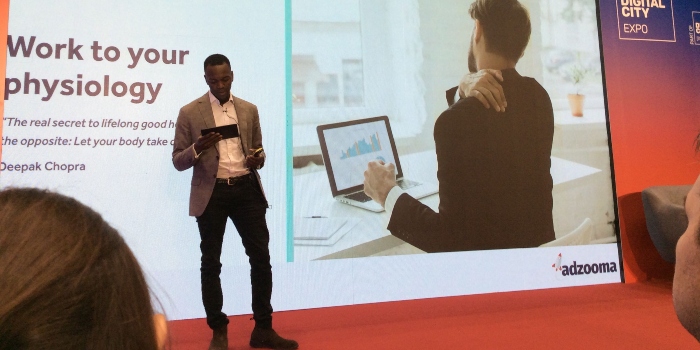
Sal Mohammed, Partnership Manager at Adzooma
He continued by saying, “The goal is to become a magnet, by setting up processes where the relevant information you need comes readily to you. Or at the very least, making your trip to the information a short one.”
So, with all this information at our fingertips, what can you do to separate yourself from the rest and turn data into actionable insights?
Sal suggested leveraging platforms that have already done the hard work of gathering the data you need. Below is a list of tools Sal mentioned which can help you get started:
Feedly: allows you to organise all your trusted sources in one place. Their AI then reads your feed and prioritizes the topics, events, and trends that matter to you.
Google trends: also a useful tool to sift through at the beginning of each day, just to make sure you haven’t missed any massive events worldwide.
Brand 24: if you like being up to date and receiving news right after they’re published, a social listening tool might be a good solution for you. You can gather consumer insights and analyse conversations about your company, products and competitors.
Another option would be to invest in a data management platform. This will allow you to make information and stats available to the whole company.
The average employees spend an average of 5 hours every week waiting to get in touch with people that have the unique knowledge they need.
If you’ve got deep pockets and little time, then you can even just use Ask Wonder, a service that will get you data and research on basically whatever question you want to answer.
As marketers, we focus a lot on the future and where we need to invest our resources next.
Guess what? Consumers don’t care about that.
During the session on “How Tech is Changing How We Access Goods and Services”, David Gore, Head of BJSS Industries, told the crowd how consumers don’t care about what’s next in the future for the technology sector. He said, “all they want to know is how they can get the product they want, in the manner they want”.
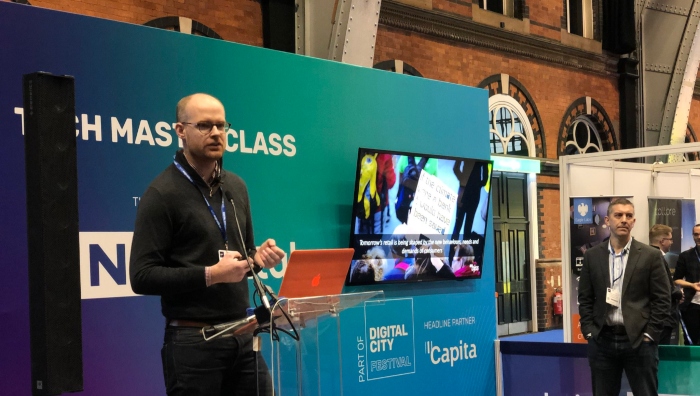
Source: David Gore, Head of BJSS Industries. How Tech is Changing The Way We Access Goods and Services.
He continued to say that, “relevancy is still gaining traction and is still climbing day-on-day, month-on-month. I have a greater demand around what is more convenient for me, and you do as well. And those brands that will survive going into the next decade are the ones who crack those [demands].”
The second part of this session was hosted by Steven Gatenby, Head of Product at Co-op Ventures. He started by talking about open innovation and provided tactics on how companies can utilise it to deliver great products and services.
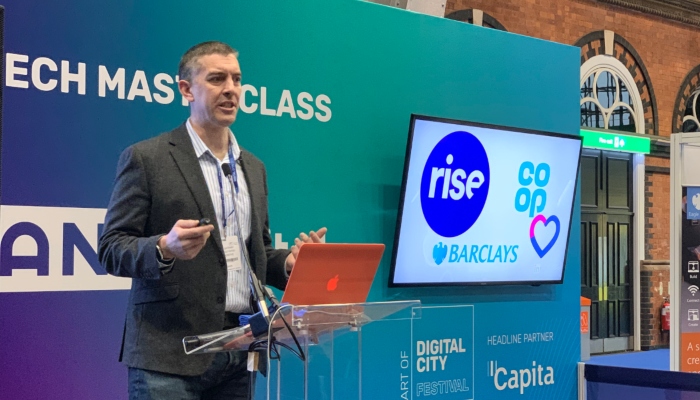
Source: Steven Gatenby, Head of Product at Co-op Ventures. How Tech is Changing The Way We Access Goods and Services.
For those of you who don’t know what open innovation is, it’s an alternative to this conventional method of doing innovation where information has to stay within the four walls of your business. It’s the belief that individuals, or companies, outside of the organisation can also contribute to generate ideas and achieve innovation.
The bottom line is that, if brands and their marketers want to see another day, then they need to wake up and give their consumers what they want.
This goes beyond discount codes and BOGOFF deals. Sure, these are common promotional tactics, but you couldn’t possibly build a business on these. The key is to simplify your customer journey and provide consumers with the best possible buying experience so that they come back for more.
In fact, according to a survey by Digital Dot, 33% of eCommerce brands are adopting live chat to help fulfil their consumer’s needs.
So many beloved brands have gone into administration just because they weren’t prepared to innovate.
For example:
In 2008, Blockbuster had the opportunity to buy into Netflix but decided against the offer because they were convinced that they knew what they were doing. Two years later, Netflix goes on to be worth over £1-billion.
Growing up in the 90s, Blockbuster was the best place to be on a Friday night. So, the closure of the popular video rental store was sad news for a lot of millennials.
That said, if we had to pick between Blockbuster and Netflix, I think it’s pretty clear which one would come out on top.
To round off this takeaway, I’m going to leave you with this quote from Mark Curtis-Wood of Vaioni Group Limited who ended Day One at the Tech Zone with his presentation on ‘How Tech is Shaping the Customer Experience’.
“Customers want more control. They want better access to data and want to be able to make better decisions.” – Mark Curtis-Wood.
To see things differently can help you understand your customers better.
During his presentation, Steven Gatenby said, “it’s very easy for anybody to start seeing things through a fixed pattern, through a very fixed lens.”
Steven then ran a non-scientific, but a quite fun example to help support his statement.
He asked us what we saw in the example below.
Before you move on.
Try and guess what it is:

Source: How Tech is Changing How We Access Goods and Services by Steven Gatenby, Head of Ventures at Co-op.
It’s an upside-down frog.
Someone in the crowd got it right.
Me? I thought it was a crocodile.
He finished the experiment by saying, “if you look at things from different angles, you see things that you might have missed before.”
This part of the session took me back to an incident that happened in the office not so long ago. One of our users had published a blog on marketing terminology and had dropped Ruler Analytics a mention.
Naturally, being in the marketing industry for 5-years, I was well aware of these phrases.
However, later that day, my colleague on the customer service term turned to me and said, “this jargon guide is so good. I’ve always wondered what some of these terms mean”.
I think this is where a lot of us marketers go wrong.
When you work in a profession like marketing, it’s so easy to get wrapped up in industry terminology and tools.
Sometimes, we assume that our audience knows what we’re talking about.
A while back, I had a client who I ran Facebook paid campaigns for.
It was spending a lot of money, so I’d have regular calls on how it was performing.
The campaign was driving brand awareness, as well as retargeting previous website visitors. For weeks, I’d go on about how we need to provide more value at the “top-of-the-funnel”.
During one call, the client asked, “what does top-of-the-funnel mean?”
Sometimes it’s so easy to get caught up in the latest tools, platforms and marketing messages we turn a blind eye to what’s best for the customer experience.
According to a survey by iProspect, 79% say having a connected data strategy is the most important component of a successful digital transformation plan.
Anthony Hess, Client Partner at MIQ, and Rob Linton, Director of Key Accounts at MIQ, hosted a talk on the Media Zone Stage on ‘How Companies Can Continue to Innovate in a Privacy-First World’.
The session developed into how this will affect campaigns moving forward, in particular, how businesses utilise effective CTAs to drive online leads via their offline activity such as print advertising, tv and radio.
Requesting a show of hands, the MiQ team asked the audience who felt their offline campaign creative considered the online footprint.
While a few agreed, the general consensus felt there was a misalignment between online and offline activity.
MiQ recommended taking a ‘think digital first’ strategy when it comes to creative by using contextual data, which could be translated into all parts of the customer’s journey.
A customer may become aware of your brand offline, research further online and then convert the sale over the phone.
Being able to effectively track this fragmented activity and attribute revenue back to the source is key to truly understand customer behaviour, evidence the effectiveness of all campaigns and optimise performance for future activity.
Over the two days, the team and I took away valuable insights.
Some, we have already applied to our day-to-day processes.
One thing I learned, in particular, is that myself and Amy O’Neil (Ruler Analytics Partnership Manager) can’t be trusted on our own for more than 10-minutes.
At one point, Amy and I ended up in inflatable wrestling suits at Paragon Digital:
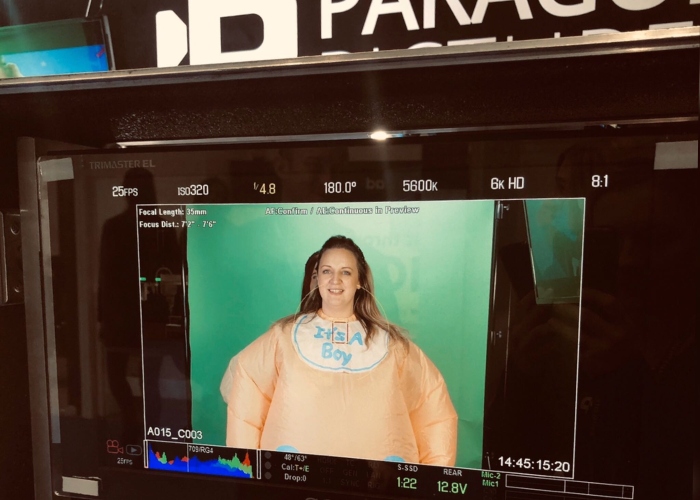
Paragon creates motion content for TV and the digital world. They have worked with leading brands such as My Protein and Boohoo. If you’re ever looking for commercial motion content, then I’d recommend reaching out to the production team.
And, how could I NOT mention the Derby stand hosted by Silverchip? It took us a few goes, but Ruler Analytics went on to win the Derby “cup”.
The winning streak didn’t stop there either. Our Head of Marketing, Dave Smithbury, also took the leaderboard by storm at the peek&poke stand.
This was my first expo, and it certainly didn’t disappoint.
If you’re heavily involved in the digital and tech industry, I’d recommend taking the trip to Manchester Central next year.
Want to exhibit at the Digital City Expo in 2021? Pre-register now. Click for more information.